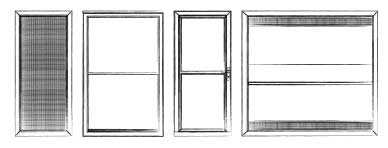WHAT IS THIS WATER ON MY STORM DOORS AND WINDOWS?
Water or frost on doors or windows is condensation. Condensation is formed when warm moist air comes in contact with cooler dry air just as a bathroom mirror will “steam up” after a hot shower. The inside or outside of your door or window can sweat or fog because of temperature differentials. 
ARE MY STORM DOORS OR WINDOWS TO BLAME?
Storm doors or windows do not cause condensation. Glass is usually the place you first notice condensation because glass surfaces have the lowest temperature of any of the interior surfaces in the house.
THEN WHAT IS THE CAUSE?
The moisture in the air causes condensation. The reason you may observe more condensation in your home is because of modern energy efficient homebuilding techniques and products. The insulation and construction materials used today are designed to keep cold air outside. This is especially true of new doors or windows. While energy efficient designs and weather stripping keep cold air outside, they also keep warm moist air inside. Older window designs were less efficient, and consequently allowed moisture to escape.
If you didn’t have as much condensation before replacing your old doors or windows, it’s probably because they were drafty. Good doors, windows, and insulation all create barriers to the air exchange of a home. When combined with the additional water vapor (moisture) from showers, cooking, or from clothes dryers not vented to the outside, the result is excess moisture and a high relative indoor humidity level.
HOW CAN CONDENSATION BE REDUCED?
The key lies in controlling the humidity inside your home. First, let’s understand where the moisture comes from. During the hot humid summer, your house absorbs moisture. The same principle applies to a newly constructed or remodeled home, due to the abundance of moisture from the building materials used in construction.
During the beginning of the winter when you start to heat your home, condensation occurs. After a few weeks, your home will begin to dry out and you’ll see less condensation. Opening a window briefly is a quick temporary solution. The dryer cold air will enter the room while the moist air is allowed to escape.
Other steps to take include:
- Cracking open a window or door daily to air out your house.
- Opening a window or running exhaust fans longer in the kitchen, bathroom and laundry room.
- Opening drapes and blinds, allowing air to circulate against windows.
- Turning off any humidifying devices in your home.
- Installing and using a dehumidifier.
If you live in a northern climate, the above as well as the following points may be relevant.
- Adding storm windows.
- Keeping plants in a sunroom, or in rooms that are infrequently used during extreme cold weather.
- Adding waterproofing protection to basement floors and walls.
- Removing radiator pans until sweating has been eliminated.
- Making sure that open-faced gas heaters are connected to a chimney and using them as little as possible.
WHEN SHOULD I BE CONCERNED?
Door and window condensation should only occur during extreme temperature differences and should be of a fairly small amount. During the winter months, condensation will be seen on the inside of the door or window. Condensation will present itself on the outside of the window during the summer months.
If you find condensation between the two layers of glass in an insulated window, or between a prime window or door and a storm window or door the airtight seal around the prime door or window has probably been broken.
If there is too much moisture inside the home, you will find evidence during both the cold and warm seasons. Moisture spots on the ceiling or walls, peeling paint, rotting wood or delaminating plywood, moisture on exterior walls, fungus, mold, or mildew growth are signs of a more serious moisture problem. Should you experience these symptoms, an expert heating & cooling contractor should be contacted in order to solve your problem.
.png?width=800&height=202&name=Logo_Larson_Script_95k%20(1).png)



 CHAT WITH US
CHAT WITH US 888.483.3768
888.483.3768